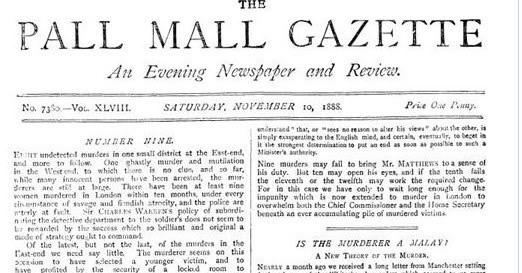The Pall Mall Gazette was a popular conservative newspaper, known for its news and reviews. Throughout W.S. Gilbert’s career, he was no stranger to the pages of the Pall Mall Gazette. His Savoy Operas were often reviewed within its pages and he was also regularly interviewed at his home in Grim’s Dyke. The earliest interview being published on 21st January 1887 (Ruddy-Gore and Savoy Operas), with the final one being published on the 22nd October 1906 – with an interview that covered The Revivals at the Savoy.
The Pall Mall Gazette was a contemporary evening paper that served as an early example of investigative journalism. Reporters would investigate, immoral, scandalous or illegal activities and the research was often completed undercover and at some peril for the reporter. These American tactics created hard hitting stories, designed to create change in both society and the Law.
Pall Mall Gazette beginnings
Taking its name from a fictional newspaper conceived by William Makepeace Thackeray in his novel ‘The History of Pendennis, the Pall Mall Gazette was founded on 7th February 1865. For the next fifteen years it was owned by George Smith, with Frederick Greenwood as its editor.
After Greenwood’s resignation in 1880, the paper was bought by Henry Yates Thompson, who changed its direction from supporting the Conservative Party policies to those of the Liberal Party.
A new style of journalism was born
Three years later, William Thomas Stead became the new Editor, and this is when it became more hard-hitting and journalistic in nature, as his new style of journalism went on to pave the way for the modern tabloid British paper. Subjects such as child prostitution helped shape government policies but during the research, Stead was arrested for ‘unlawful taking of a child’. He’d agreed to buy a 13-year-old girl for £5, part of his investigation, but resulting in his imprisonment for three-months.
The child prostitution piece was incredibly popular though, with copies of the paper changing hands for 20 times their original value. 10,000 members of the public besieged the office and the Gazette’s supply of paper ran out and they had to use supplies from their rival, Globe. This kind of journalism distressed Thompson though, who subsequently dismissed Stead and hired Henry Cust – who returned the paper back to its Conservative beginnings.
A time of uncertainty
Thompson remained owner of the Pall Mall Gazette until 1896, before selling it to William Walforf Aster. Aster continued to own the paper until 1917. Circulation declined during this time, under the editorship of Frederick Higginbottom, but increased and again, when James Louis Garvin took up the position. D.M. Sutherland became its new Editor in 1915 – becoming its last Editor.
Henry Dalziel became the final owner of the Pall Mall Gazette, in 1917, lasting for 6 years, until, in 1923 the paper was absorbed into the Evening Standard.
The impact the Pall Mall Gazette had on Britain
In its time, the Pall Mall Gazette had several well-known writers contribute to its pages. George Bernard Shaw cut his journalism teeth writing for the paper, whilst Oscar Wilde, Robert Louis Stevenson and Sir Spencer Walpole, all contributed to its pages.
Throughout its 58-year lifespan, the Pall Mall Gazette not only gave new and well-known writers a platform, it also played a crucial part in shaping modern journalism – and for that, it deserves to be fondly remembered.


